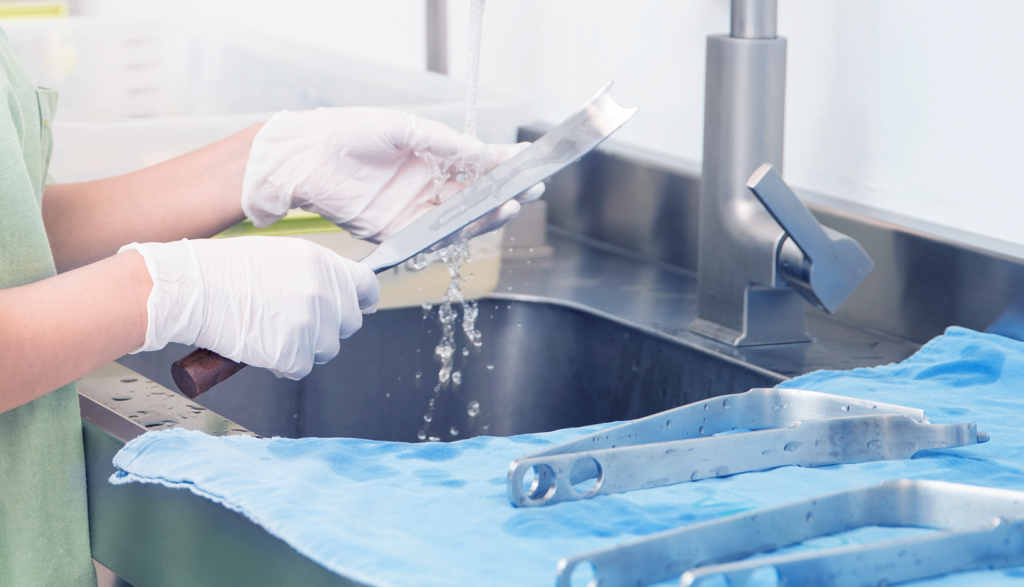How do you have to clean medical devices? And why is that process so complicated? It boils down to a few questions:
- Why do you need to sterilize or disinfect medical equipment?
- What determines how clean a medical device needs to be?
- Who should clean these devices? And When?
- Where are medical devices found?
- How do you design medical equipment for sterilization?
Medical devices are used in high-risk environments. Some devices are exposed to infectious pathogens, or directly to patients’ bloodstream and each device requires a different amount of sterilization and disinfection.
Why do you need to sterilize or disinfect medical equipment?
Health care environments are places where harmful pathogens, germs, and bacteria live and spread. It is crucial that the proper protocol is in place to sterilize and/or disinfect medical devices before and after use.
Cleaning medical devices and equipment protects patients and caregivers by ensuring that harmful material is stopped in its path before it can spread. Alongside the cleaning protocols outlined in this article, caregivers must also follow OSHA and CDC best practices for keeping the spread of pathogens to a minimum.
“Best practice” mandates wearing appropriate PPE, such as rubber gloves, gowns, face shields, splash shields, and shoe covers. Caregivers also receive training in the form of an exposure control plan, or based on standards such as the “OSHA blood spill procedure” or the “Needlestick Procedure”. These give guidelines for cleaning up after any amount of exposure to bodily fluids (blood, saliva, etc.) that may contain infectious material or fluids that came from a person who is infected.
What determines how clean a medical device needs to be?
The environment that the device is in, what the device will be used for, and what materials the device is made of all determine what level of sterilization or disinfection is needed.
All devices must be pre-cleaned before they can be disinfected or sterilized. Depending on what the device comes into contact with determines the level of sanitation needed. There are three levels:
1. Critical Care Devices – Sterilization
Sterilization means to kill all microbial life. Most commonly, medical devices are steamed in extreme heat in order to sterilize them, but there are also chemical sterilants used as low heat alternatives for devices made with plastics. Most devices that must be sterile for use can be purchased sterile. After that, they need to be sterilized before use on each patient due to the high risk of pathogen exposure.
Devices in this category include anything that comes into contact with sterile body tissues and fluids, such as internal organs or the cardio-vascular system. This includes surgical equipment, catheters, and implants.
2. Semi-Critical Devices – High-Level Disinfectant
High-Level Disinfectant is any form of disinfection that kills all living organisms, except high levels of bacterial spores. High-level disinfection is usually performed using a chemical disinfectant such as Glutaraldehyde, hydrogen peroxide, ortho-phthalaldehyde or other chemicals cleared by the Food and Drug Administration (FDA). These are also qualified as dependable high-level disinfectants. After high-level disinfection, devices should be rinsed of all chemicals using sterile water.
The choice to use one disinfectant over another mostly depends on the material the device is made of. Many plastics will corrode under repeated exposure to harsh chemicals, so designing the device with cleaning protocols in mind is a must.

200+ Cleaning Chemicals to Consider During Development
Use our list of more than 200 common cleaning chemicals found in hospitals to assure your medical product is designed properly for this harsh environment.
Something else to consider is “dwell time” or the amount of time a chemical must be exposed to a surface in order to kill microbes. This is product-specific, and all disinfectants are tested for an approximate dwell time, listed on its container.
Semi-critical devices are exposed to mucous membranes (nose, pharynx, esophagus, etc.), or non-intact skin. Devices in this category include anesthesia breathing circuits, respiratory therapy, and endoscopes.
3. Non-Critical Devices – Intermediate/Low-Level Disinfectant
Low-level disinfectant kills some viruses and bacteria with a chemical germicide registered as a hospital disinfectant by the EPA. Devices in this category only need to be cleaned when visibly soiled and on a regular basis (such as after use on each patient or once daily or once weekly: see Recommendation 5g). Devices should always be disinfected after contact with a patient who is on contact precautions.
These devices may come into contact with intact skin and therefore are lower risk than the devices in the other categories. Non-critical devices are divided into two categories: “patient care” items such as blood pressure cuffs or IV poles, and “environmental surfaces” such as computers, lab benches, and bedrails.
Who should clean these devices? And When?
Patient-Care Devices
Most hospitals perform disinfection and sterilization of patient-care devices in a central processing department in order to more easily control quality. In hospitals, a sterile-processing technician would manage these devices, whereas larger facilities have their own re-processing center.
The best practice is to pre-clean patient-care devices with water and detergent, or an enzymatic cleaner, before high-level disinfection or sterilization according to the devices IFU.
Pre-cleaning helps to remove visible organic residues, such as blood and tissue, and inorganic salts. Cleaning devices as soon as you are practically able also helps to prevent contaminants to dry on or stick to devices, which could make sterilization less effective.
Cleaning can be performed manually using friction and fluidics, or mechanically with ultrasonic cleaners, washer-disinfector, washer-sterilizers. Cleaners should be as close to a neutral (7) PH as possible for compatibility with materials and other disinfectants.
Environmental Surfaces
Any surface exposed to a contaminant must be cleaned, as well as any medical devices that could have been contaminated through proximity or direct contact through a spill or drip.
For example, in a lab environment, any time a test comes back with a positive result for an infectious illness, anything that could have come into contact with that test has to be cleaned. If not, this could lead to the spread of disease or to cross-contamination in other test results.
Nurses and caregivers, or lab technicians, are usually responsible for low-level disinfection of the patient care devices they use and the environmental surfaces they contact. Even non-critical devices are cleaned between uses.
Where are medical devices found?
Although these are standard procedures, each care facility, and each device has its own set of rules on how to disinfect or sterilize, and each place may use a different method, chemical solution, or detergent to get the job done. It is important to know these procedures before developing a medical device so that the best materials can be used in development to suit these requirements.
Hospitals
All rooms in the hospital are required to properly use disinfectant including cleaning noncritical and environmental surfaces consistently.
Hospitals consider the makeup of the disinfectant or detergent being used, the cost, material compatibility, shelf life, and disposal when deciding on what to use.
Specialized environments such as operating rooms require more strict protocol, and some require ventilation to disinfect the air as well as sterilizing surfaces.
Infant environments
In infant and pediatric environments, more care is given to the choice of disinfectant because they are more at-risk individuals and cannot be exposed to certain chemicals.
Home Care
Home care devices use the same classification scheme as any other environment (critical, semi-critical, non-critical). The main difference is that person-to-person transmission is less likely in the home.
Caregivers, and device makers, are responsible for teaching home care users on infection-control for each device including cleaning and disinfecting equipment, as well as safe storage.
Ambulatory Care (outpatient medical/surgical facilities)
The risk of exposure is just as high in ambulatory care as in a hospital setting because, in these environments, exposure to bodily fluids and non-intact skin is likely. There is also more risk for person-to-person transmission than in the home care setting.
How to design medical equipment for sterilization.
In addition to the function of the device and how it will be used, the design of the instrument can determine the level of disinfection needed. Semi-critical devices with intricate mechanics may need to be sterilized because harmful pathogens could remain inside these crevices.
Another way medical equipment design can help mitigate the spread of pathogens is through engineering and design controls. This includes a list of requirements your product must adhere to in order to be considered a suitable product. The level of sterility required, as well as the standard method used for cleaning, should be added to the product requirements document.
When considering the cost of developing a medical device, life cycle costs must be considered. Although a product could be cheaper to produce and could sell for less, cheaper materials may be less durable. The negative impact on surface materials caused by harsh chemical disinfectants may require replacing hard surfaces more frequently.
Building a medical device that is suitable for its environment and use is essential, and considering everything you need to build a fool-proof medical device beforehand means making cleaning and sterilization easier and more effective.





